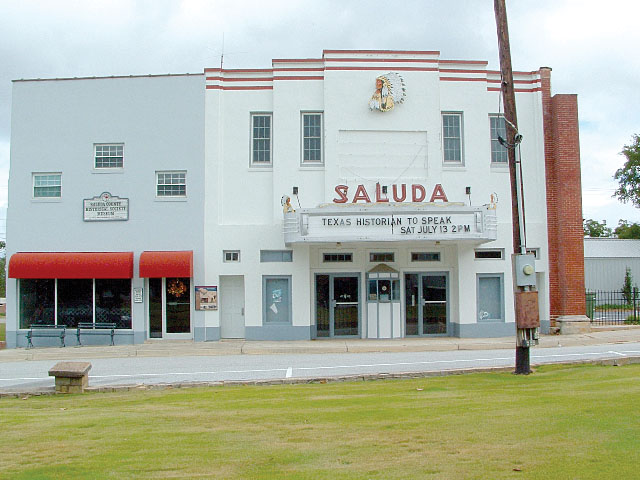
A Cartoon, a Newsreel and a Talkie for a Nickel?
No; but it is a very cool looking theater. Check it out – and more – in downtown Saluda.
For many years I drove down Highway 378 to my family home in Georgia. The journey took me through downtown Saluda. There I noticed a handsome old theater, the Saluda Theater. I didn’t know much about it, but that changed in 1987 when I was working on a book for the University of South Carolina Press. When researching and writing “South Carolina, A Timeless Journey,” I wrote a chapter, “Highway 378,” in which I covered the Saluda Theater. What a great history this theater owns. Drive 60 miles southeast and you can see the handsome theater and its colorful sign.
The theater, built in 1936, is 78 years old. Back when I interviewed Mary Parkman, then-executive director of the Saluda County Historical Society, she said the theater opened with Shirley Temple’s “Susanna of the Mounties.” Over the years the theater hosted Lash Larue, the whip-wielding cowboy, and other notables. When cable TV and the video rental explosion hit, the old theater’s days were numbered. It closed in 1981 after a 45-year run and gathered dust.
It was a good day in 1987 when Saluda County bought the theater and donated it to the local Historical Society. Renovations followed and in August 1990 the ABC-TV miniseries used the theater as the set for a scene in “And Justice For All.”
Back in its heyday, two old arc projectors that burned carbon rods stood side by side back of the balcony. Those old projectors put out a ton of heat and fire was a possibility. The small projection booth where they stood had two trap doors held open by cotton strings that ran across the lens housing. If the projectors overheated the strings caught fire, burned in two, and trap doors slammed shut, shutting off the supply of air, a rudimentary safety strategy.
Today the theater is on the National Register of Historic Places. If you make the trip to see it you will see that it looks much like it did in 1936. Its art deco design supports the fact that it was built in 1936, a time when precise and boldly delineated geometric shapes and strong colors dominated architecture in small towns. Few theaters like the Saluda Theater exist in the United States today. Appropriately, a museum stands adjacent to the theater.
Native American history is strong in Saluda County. When you go, be sure to check out the mural across Highway 378 that depicts Old Hop and other Cherokee chiefs ceding their territory to Governor Glen on July 2, 1755. As well Saluda County has ties to the Alamo. Native sons William Barrett Travis and James Butler Bonham were at the Alamo where both died in the Texas Revolution. Locals like to say “Saluda County is where Texas began.”
Plan a drive over to Saluda and ask about other historic sites such as “Flat Grove” and the Marsh-Johnson House.
If You Go …
• Make your way to Highway 34 and follow it to downtown Saluda. The theater is adjacent to the courthouse at 107 Law Range.
• Learn more about the Saluda Theater at www.saludacountyhistoricalsociety.org/saluda-theater/12-saluda-theater.html
Learn more about Tom Poland, a Southern writer, and his work at www.tompoland.net. Email day-trip ideas to him at [email protected].











